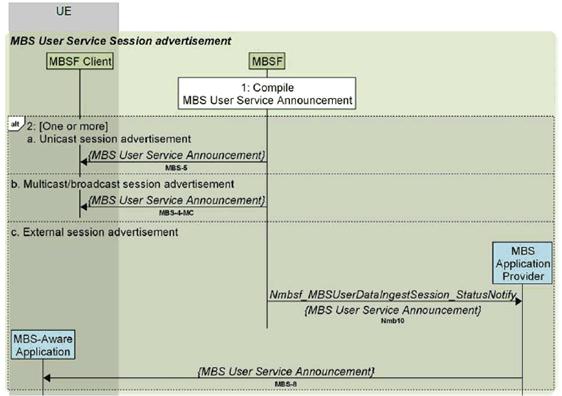Content for TS 26.502 Word version: 18.1.0
5.4 Procedures for User Service advertisement/discovery p. 46
At this point, the MBS User Service Session is advertised to the MBSF Client, as shown in Figure 5.4-1 below, using one or more of the User Service advertisement modes defined in clause 4.2.4.

Figure 5.4-1: Call flow for MBS User Service advertisement/discovery
(⇒ copy of original 3GPP image)
(⇒ copy of original 3GPP image)
The steps are as follows:
Step 1.
The MBSF may rescind an MBS User Service Announcement at any time for operational reasons.
The MBSF compiles a composite MBS User Service Announcement from the set of individual MBS Distribution Session Announcements compiled in step 14 of clause 5.3. The compiled MBS User Service Announcement describes the current set of MBS Distribution Sessions that comprise the active MBS User Data Ingest Session. The advertised start date-time is the next start time indicated in the MBS User Data Ingest Session schedule of active periods, or the current date-time if no schedule is provisioned.
Step 1a.
The MBSF publishes the compiled MBS User Service Announcement to the MBS AF via reference point MBS-3 (not specified).
Step 2.
The MBS User Service Announcement is distributed using one or more of the following mechanisms:
-
The MBSF passes back to the MBS Application Provider a list of External service identifiers identifying the MBS User Service in question by invoking the Nmbsf_
MBSUserDataIngestSession_ callback service operation at reference point Nmb10 (or Nmb5+N33, if invoked via the NEF) using the User Service advertisement event. The MBS Application Provider advertises an external service identifier to the MBS-Aware Application by private means at reference point MBS-8. When the MBS-Aware Application subsequently selects the MBS User Service, it invokes a suitable client API at reference point MBS-6, passing the external service identifier as a parameter. As a result, the MBS Client fetches MBS User Service Announcement at reference point MBS-5 using the provided external service identifier.StatusNotify -
An object manifest for the MBS User Service Announcement Channel is compiled by the MBSF. This lists all of the MBS User Service Announcements to be made available in the corresponding MBS Distribution Session and indicates that the objects listed should be polled for updates.
If the MBS User Service Announcement Channel is provisioned for pull-based object acquisition (illustrated), the object manifest for the MBS User Service Announcement Channel is published by the MBSF to the MBS AF via reference point MBS-3 (not specified) and made available as a resource for unicast retrieval by the MBSTF via reference point MBS-11 at the location indicated by the object acquisition identifier provisioned for the corresponding MBS Distribution Session (see step 3 in clause 5.3A). The object manifest is pulled by the MBSTF from the MBS AF at this reference point, as defined in clause 4.3.3.2. The MBSTF continues to monitor the MBS AF for changes to the object manifest and retrieves a new copy as needed.
If the MBS User Service Announcement Channel is provisioned for push-based object acquisition (not illustrated), the object manifest for the MBS User Service Announcement Channel is published by the MBSF to the provisioned URL path on the MBSTF via reference point Nmb2, as defined in clause 4.3.3.2, whenever it changes.
For both pull- and push-based acquisition, the MBSF invokes the Nmbsf_
MBSUserDataIngestSession_ callback service operation at reference point Nmb10 (or Nmb5+N33, if invoked via the NEF) using the User Service advertisement event to inform the MBS Application Provider that the MBS User Data Ingest Session is being advertised. The notification conveys a list of External service identifiers identifying the MBS User Service in question. For both pull- and push-based acquisition, the MBS User Service Announcement itself is pulled from the MBS AF by the MBSTF at reference point MBS-11 as directed by the object manifest for inclusion in the MBS User Service Announcement Channel carousel, as defined in clause 4.3.3.2. In addition, the object manifest may direct the MBSTF to fetch ancillary objects (e.g., Application Service Entry Point documents referenced by the MBS User Service Announcement and/or MPEG-DASH initialisation segments) for inclusion in the MBS User Service Announcement Channel carousel. Because it is directed to do so by the object manifest, the MBSTF polls the MBS AF for changes to these objects and retrieves new copies as needed to replace the previous versions in the MBS User Service Announcement Channel carousel. As a result, the most up-to-date MBS User Service Announcement and any ancillary objects are delivered repeatedly by the MBSTF to the MBSTF Client via the MBS User Service Announcement Channel at reference point MBS-4-MC using the Object Distribution Method. Subsequently, by invoking a suitable client API at reference point MBS-7' API, the MBS User Service Announcement is forwarded by the MBSTF Client to the MBSF Client. Having earlier received the User Service advertisement event, the MBS Application Provider advertises one of the External service identifiers identifying the MBS User Service (see Table 4.5.7-1) to the MBS-Aware Application by private means at reference point MBS-8. The MBS-Aware Application subsequently uses this identifier to select the MBS User Service by invoking a suitable client API at reference point MBS-6.StatusNotify -
The full MBS User Service Announcement is passed back to the MBS Application Provider by invoking the Nmbsf_
MBSUserDataIngestSession_ callback service operation at reference point Nmb10 (or Nmb5+N33, if invoked via the NEF) using the User Service advertisement event. As a result, the MBS Application Provider advertises the MBS User Service Announcement to the MBS-Aware Application by private means at reference point MBS-8. When the MBS-Aware Application subsequently selects the MBS User Service, it invokes a suitable client API at reference point MBS-6, passing the full MBS User Service Announcement as a parameter.StatusNotify